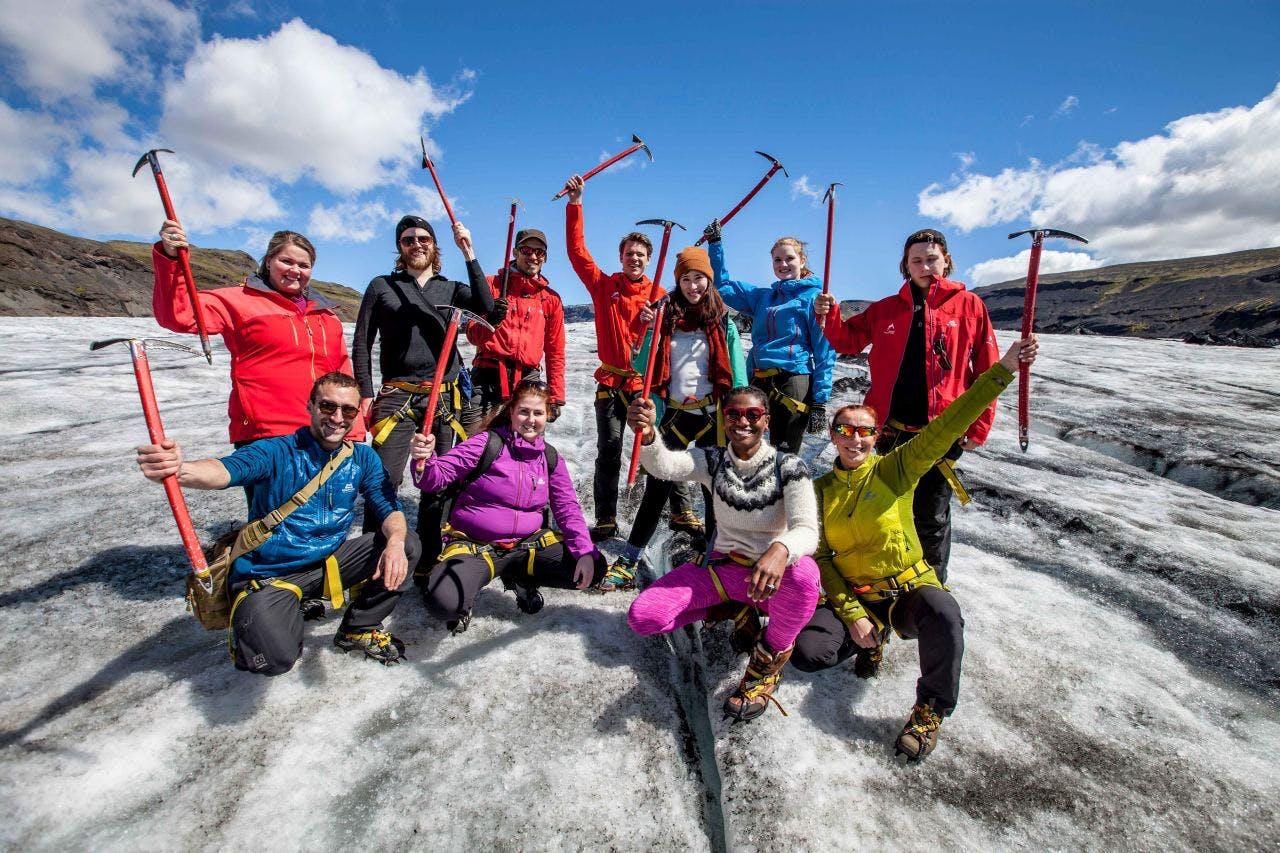The Ultimate Guide to Glaciers and Glacier Hikes in Iceland
|
Aerial view of a blue glacier Thrilling blue glacial crevasses
Table of Contents
It’s no accident Iceland is called the ‘Land of Fire and Ice’. Apart from its volcanoes - some of them topped by glaciers - 11% of the country is covered in ice caps and outlet glaciers. With these glaciers under threat, there’s no better time to come and explore these places of bewitching beauty.
Iceland is a top destination for glacier hikes, its guided tours second to none, and Icelandic Mountain Guides are world-leading experts in glacier exploration. Choose your optimal tours, and glacier hike Iceland with this ultimate guide.
What are glaciers?
Glaciers may look inactive, but in reality, they’re on the move, slowly being pulled downwards by the force of gravity. They shape mountains, carve out valleys, and shift large amounts of rock and sediment. Consisting of compacted snow compressed into ice over many centuries, glaciers are the remnants of ice sheets that covered the Earth during the Ice Age.
How are glaciers formed?
Glaciers form when more snow accumulates each year and then melts away during summer thaws. The snow builds up year after year, only the surface melting. With winter, the surface refreezes. New snow falls and buries the harder, icier snow called firn.
The process is repeated with layers of firn building on top of each other until, around 50 metres deep, the firn fuses into a solid mass. At this point, the glacier begins to move under its own weight like an extremely slow-moving river.

Blue ice crevasses are a stunning example of nature's art
What are ice caps, outlet glaciers and ice tongues?
Ice caps are glaciers covering less than 50,000 square kilometres. They’re usually dome-shaped, spreading out from their centre and covering everything in their path: entire valleys, mountains and plains.
Outlet glaciers are arms of ice (often called glacier tongues) that extend down through valleys from the ice caps. An ice tongue forms when a valley glacier moves out into an ocean or lake. It can increase in size from water freezing at the base or from falling snow. Its mass, in turn, can also be lost by melting (calving). Icebergs form when ice tongues break off from the main glacier. This is what you see at Jökulsárlón.
Why is glacial ice blue?
Glacier ice appears blue because white sunlight entering it travels much further than it does through opaque snow. This gives the translucent or transparent ice time to absorb more red than blue light. The shorter (blue) wavelengths are transmitted and scattered through the ice. The deeper the ice, the more scattering, so the bluer it appears.

Stunning ice formations on Vatnajökull glacier Stunning ice formations on Vatnajökull glacier
What are the most common Glacier ice features?
- Crevasses form with the movement of glaciers, creating deep and narrow cracks. They are extremely dangerous, seemingly appearing from nowhere or changing form from one day to the next. They may also be invisible to the hiker when covered in snow. Crevasses, on average, drop around six metres, but they can be as deep as twenty. This is why you should never attempt to walk on a glacier without an experienced guide.
- Icefalls occur on steep sections of a glacier. In effect, it’s a frozen waterfall, forming when the glacier moves at speed over a steep decline and creating a jumble of jagged blocks (serac) as the ice stretches and thins.
- Moulins are vertical shafts in the glacier, keeping their shape because of a constant stream of water and debris.
- Glacier lagoons form at the base of glaciers. As the ice cap recedes, the space it once occupied fills with meltwater.
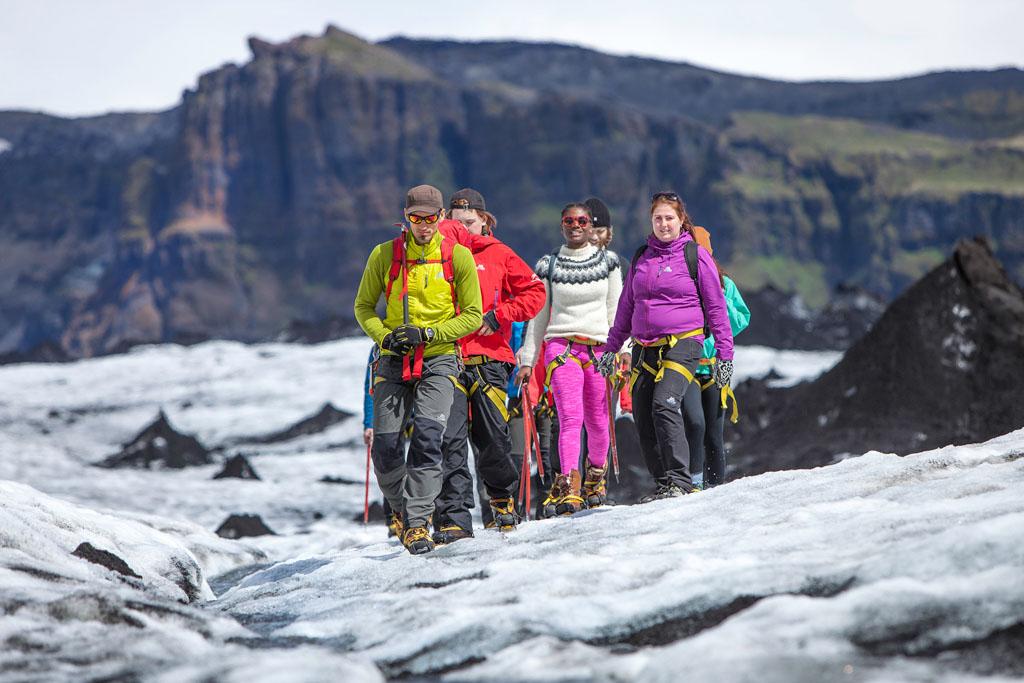
A group of glacier hikers crossing the ice field on Sólheimajökull glacier
The effect of global warming on glaciers in Iceland: Are Iceland’s glaciers receding?
Scientists warn us that Iceland’s glaciers could well be gone in 150 years - a numbing thought. This may be our last chance to experience these beautiful natural features in the Land of Fire and Ice, as shown in this Icelandic Mountain Guides video.
You may have heard the tragic story of Okjökull. “Ok Glacier” is far from okay; in fact, it’s no more. In 2014 glaciologist Oddur Sigurðsson declared it dead - a wake-up call for Icelanders and the wider world. In 2019 a commemorative plaque was raised in its place with an inscription written by Andri Snær Magnason entitled ‘A Letter to the Future’.
It reads: ‘Ok is the first Icelandic glacier to lose its status as a glacier. In the next 200 years, all our glaciers are expected to follow the same path. This monument is to acknowledge that we know what is happening and what needs to be done. Only you know if we did it’.
With that in mind, Icelandic Mountain Guides are determined to do their part, raising awareness of climate change through education and advocating for environmental action.
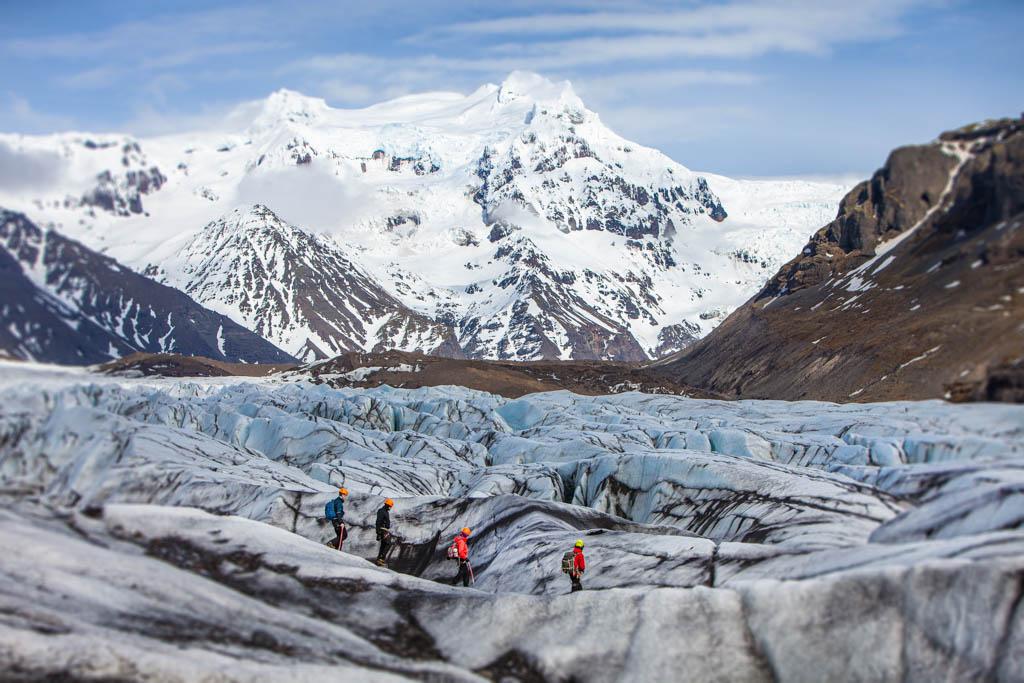
A guided glacier hike in Skaftafell
Iceland’s greatest glaciers
Vatnajökull and its outlet glaciers
Meaning ‘Vater Glacier', Vatnajökull is the largest glacier in Iceland, covering a staggering eight per cent of the country. A National Park, it’s a place of astounding beauty, much loved by hikers. The ice cap has more than thirty outlet glaciers. These are the best-known:
Skaftafellsjökull
The glacier tongue of Skaftafellsjökull sits in Skaftafell Nature Reserve, part of Vatnajökull National Park. The base at Skaftafell offers good access to the outlet glacier with plenty of scenic trails. Sadly, Skaftafellsjökull has receded dramatically over the last decade.

The Ultimate Guide to Skaftafell
Emerald green valleys, glacier tongues and jagged mountains, Skaftafell is a hiker’s paradise. Feast your eyes on the waterfall of Svartifoss: if the curtain of water doesn’t impress you, its backdrop surely will with its basalt columns reminiscent of great organ pipes.
Svinafellsjökull
Awe-inspiring Svinafellsjökull has been the setting for action dramas such as The Northman, Interstellar and Batman Begins. Unfortunately, the glacier is now out of bounds - and here climate change comes into play again: catastrophic mountain collapse and giant rock slides have posed a serious threat. Please respect the Environmental Agency closure and stay away.
Falljökull and Virkisjökull
The two glacier tongues sit side by side, outlet glaciers of Öraefajökull ice cap at the south end of Vatnajökull. The area in and around the twin glaciers is one of Iceland's most popular hiking locations. Book the Blue Ice Glacier Walk with Icelandic Mountain Guides and experience dazzling ice sculptures, deep crevasses and knife-edged ridges.
Breiðamerkurjökull and the Jökulsárlón Glacier Lagoon
Emerging as a tongue of Vatnajökull, the glacier ends at the stunningly blue Jökulsárlón Glacier Lagoon with its drifting icebergs. It’s one of Iceland’s favourite locations and nearby Diamond Beach.
At the head of the water, Breiðamerkursjökull is an impressive sight, used in Lara Croft Tomb Raider to represent the frozen wastes of Siberia. Here you can experience the mesmerising Aurora Ice Cave, its blue and green hues reminiscent of the northern lights - giving the cave its name.

An aerial view offers an entirely different perspective on this natural beauty
Iceland's second-largest glacier: Langjökull
Meaning the ‘Long Glacier’, it’s Iceland’s second largest glacier by area (not volume) and is popular with hikers and skiers alike. At 50 km long and around 20 km wide in places, it’s an impressive sight.
More spectacular glaciers in Iceland
The third largest: Hofsjökull
Located in the Highlands of Iceland, the ‘Temple Glacier’ is Iceland’s third largest glacier by area and home to one of the largest volcanoes in Iceland. It’s the source of several rivers in Iceland, including the longest, þjórsá.
The fourth largest: Myrdalsjökull, and its outlet Sólheimajökull
Sólheimajökull - meaning Home of the Sun - is an outlet glacier of Mýrdalsjökull in South Iceland. Icelandic Mountain Guides offers a number of exciting Sólheimajökull glacier hikes. You can do a combo hike and ice-climb package or a combined hike and ice cave tour.
Exploring the cave with its mesmerising blue ice contrasting with black ash is an experience you’ll unlikely forget. For something different, how about kayaking among the icebergs of a glacial lagoon surrounded by snow and ice?

Aurora Ice Cave tour
This giant ice cave showcases all the blue and green colours of the spectrum. The cave got its name when two guides were scouting around the glacier and found this beautiful ice cave while the Auroras were dancing in the sky above. It looked as if the Auroras had given parts of their sparkle to the cave itself.
Smaller glaciers
Drangajökull: One of Iceland’s smallest glaciers, Drangajökull, is located in the far northwest of Iceland of the Westfjords. It’s Iceland’s most northerly glacier and the country’s only ice cap under 1,000 metres. Despite its low elevation, it’s the only ice cap in the country that hasn’t shrunk in recent years. If you love the wilderness, hiking to the glacier is easy through low hills of wild beauty.
Eyjafjallajökull: Named one of the best hikes in the world by National Geographic, the day hike over part of the Fimmvörðuháls Trail in South Iceland is full of scenic highlights. The trail crosses between the two glaciers of Eyjafjallajökull and Mýrdalsjökull, passing lava fields and the volcanic craters of Móði and Magni, formed from the 2010 eruption of Eyjafjallajökull. We have a guided hike to the spectacular Glacier Panorama Trail with views of Eyjafjallajökull and Sólheimajökull.
Tungnafellsjökull: Located northwest of Vatnajökull, the ‘Tongue-fell Glacier’ sits in the caldera of a volcanic mountain. The 10-kilometre hike to the summit of Háhyrna by way of Þvermóður gives you fantastic views of the glacier.
Þórisjökull: Þórisjökull, situated between Langjökull glacier and the shield volcano Ok to its east, is named after Þóri from an Icelandic saga, said to live in a nearby cave. The old Kaldadalsvegur mountain track accesses it.

Sólheimajökull - Home of the Sun Glacier
The name draws you in straight away: it also happens to be one of Icelandic Mountain Guides' favourite stomping grounds. Sólheimajökull is home to a vast expanse of outlet glaciers, black sands, glacier lagoons and second-to-none hiking trails.
Eiríksjökull: Eric’s Glacier sits northwest of Langjökull, the largest table mountain in Iceland, 1,675 m at its highest point. From the trailhead, cairns mark the approach to the glacier.
Þrándarjökull: Located 20 km from Vatnajökull, this small but lovely glacier can be reached via the valley of Geithelladalur, the glacier’s meltwaters flowing through it as the River Geithellaá.
Tindafjallajökull: Þórsmörk is a mountain range located in the highlands of Iceland, located between the glaciers Tindafjallajökull and Eyjafjallajökull. Þórsmörk is an area renowned for its hiking. The glacier caps the 5-km-wide caldera of Tindafjallajökull.
Torfajökull: According to legend, the glacier is named after Torfi Jónsson í Klofa, who fled when the plague arrived in Iceland in 1493. A walk to the highest point of Torfajökull is fairly easy and safe, with superb views along the way.
Snæfellsjökull: We offer the possibility of a guided hike to the summit of Snæfellsjökull Glacier, a challenging one-day trek, but rewards you with panoramic views of Reykjanes Peninsula in the south to the Westfjords in the North.
Which glacier is closest to Reykjavik?
In the southern Highlands, Mýrdalsjökull is Iceland’s fourth largest ice cap covering a colossal 600 square kilometres. Its highest peak is almost 1,500 metres high. Most of all, it’s known for sitting on top of the infamous Katla volcano. Its proximity to the capital makes it the most famous glacier for hiking and ice-climbing.

Your Guide to the Icelandic Mountain Guides' Adventure Ground
So, you confess to being an adrenaline junkie. Hop on the Adventure Ground bus in Reykjavik, which will send you on the way to your next escapade. Anyone for snowmobiling, lagoon kayaking or glacier hiking? What about an off-road safari? We’ve got you sorted. From Sólheimajökull Glacier and Mýrdalsjökull Glacier basecamps, a world of adventure awaits you.
Which glacier is best in Iceland?
It all depends on what you want to do, doesn’t it? But don’t worry, we have you covered. Here’s the lowdown:
- Best for snowmobiling
Our ‘Top of the Pops’ for snowmobiling calls for Myrdalsjökull again. Icelandic Mountain Guides offers a thrilling snowmobile adventure year-round.
- Best for glacier hiking and ice caving: Vatnajökull
As Iceland’s biggest ice cap, you can’t beat its scope for glacier hiking. Check out our Blue Ice Glacier Walk, among other exciting glacier tours on our day tours from Skaftafell. We also offer a glacier walk and ice cave package, the perfect combo for a day on Vatnajökull.
- Best for mountaineering: Snaefellsjökull
One of the most beautiful glaciers in Iceland, Snaefellsjökull was chosen as the setting for Jules Verne’s epic ‘Journey to the Centre of the Earth’. Hike to the summit of Snaefellsjökull and drink in the panoramic views.
- Best for ice climbing: Falljökull
With its ridges, deep crevasses and ragged ice walls, Falljökull is the ice climbers' playground. Whatever your level of expertise, we’ll find the appropriate ice climb for you on our Skaftafell tour.
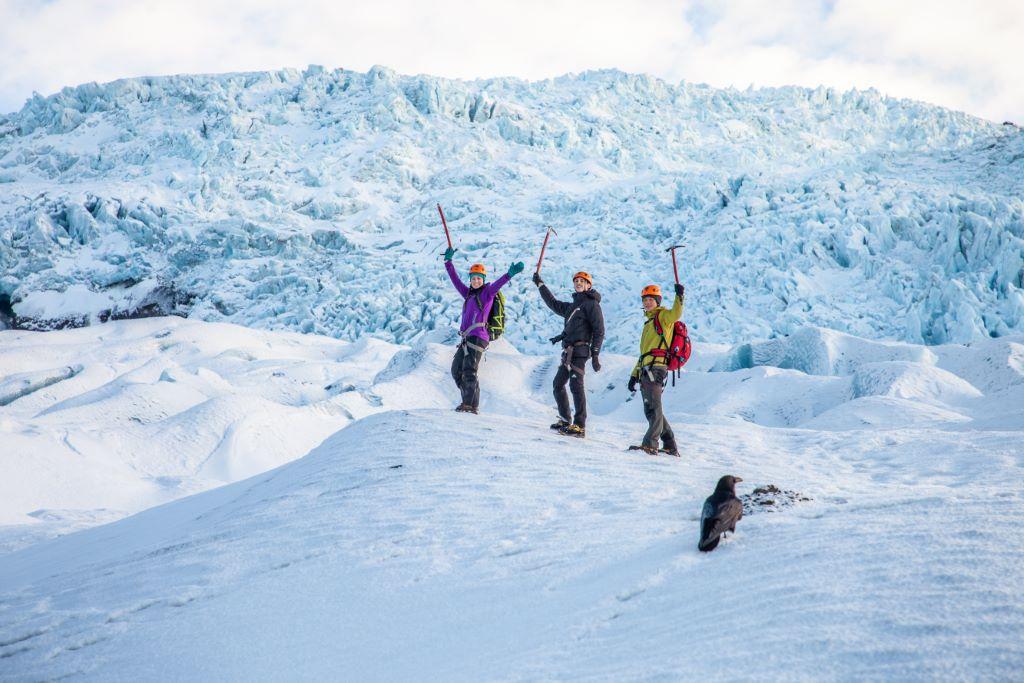
Guided glacier hiking on the stunning Falljökull glacier
The history of glacier hike and glacier tours in Iceland
The mediaeval Saga of the People of Laxardalir describes how the early settlers of Laxardal Valley crossed Ok Glacier. The first recorded glacier hike in Iceland took place in 1912 when mountaineers climbed the Vatnajökull glacier. But it wasn't until the 1950s and 60s that glacier hiking became a more common activity in Iceland.
Icelandic Mountain Guides, established in 1983, was one of the first companies to organise and lead guided hikes on glaciers in Iceland. Iceland’s very first official guided glacier hiking tour was the Icelandic Mountain Guide Glacier Walk tour, which has been unchanged since 1994 and is still operating today under the name ‘Blue Ice Glacier Walk’.
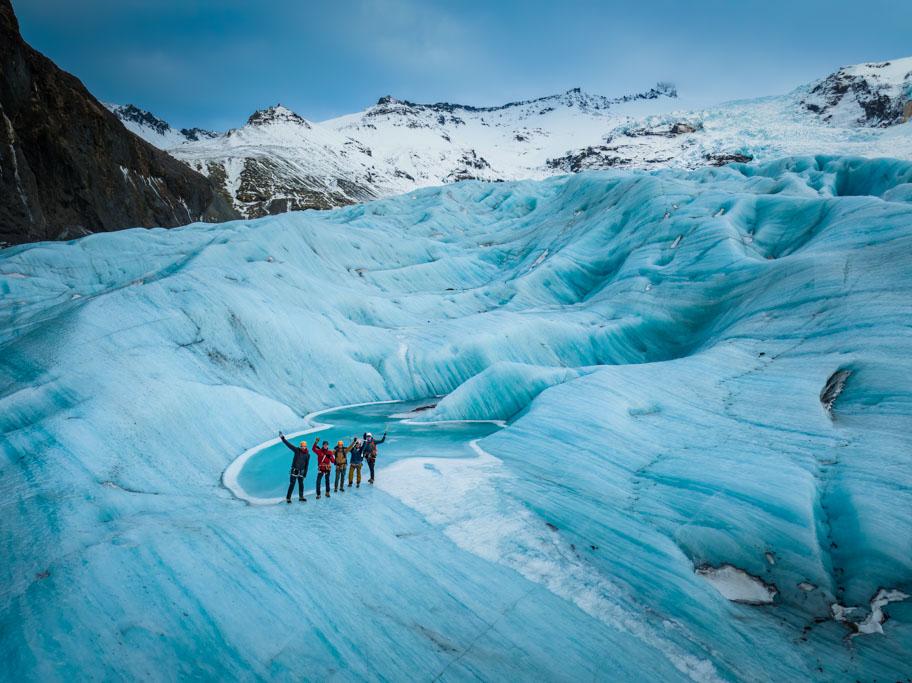
Hikers on Virkirsjökull glacier in Skaftafell
Are glacier hikes safe?
In short, yes, but only led by a qualified guide.
Can you hike a glacier on your own in Iceland without a guide?
Definitely not. Guides undertake rigorous training with regular refresher courses. They are highly skilled in risk management, navigation, first-aid, life-saving, crevasse rescue and ice climbing, and communication and management skills. IMG guides and instructors are considered the best in Iceland.
The company sets the basis for what is now the standard in training required for every guide in Iceland. Icelandic Mountain Guides has always been the biggest provider of AIMG training (The Association of Icelandic Mountain Guides). Find out more on Mountain Guides Training and Safety.

What to Wear on a Glacier Walk in Iceland
Staying warm on ice-cold glaciers is essential. Warm socks, sturdy climbing boots, a thermal base layer and waterproofs (also acting as a windshield) are all necessary along with hats and gloves. Your guide will provide crampons and ice axes and show you how to use them. Otherwise, bring snacks and drinks: glacier walking is hungry work.
Glacier Hike tours: What is the best glacier tour in Iceland?
Classic glacier hiking tours are offered on multiple outlet glaciers of Vatnajökull and Myrdalsjökull. Langjökull is primarily known for snowmobiling, while Snaefellsjökull and smaller glaciers offer more of a mountaineering experience.
For the best glacier walks or hikes, consider visiting Myrdalsjökull/Sólheimajökull or one of Vatnajökull's glacier tongues, such as Virkisjökull, Falljökull, or Breiðamerkurjökull (which also offers ice cave tours).
- The best easy glacier walk in Iceland: Glacier Walk Express.
A great introduction to glacier walking, the two-and-a-half-hour trek with Icelandic Mountain Guides is family-friendly and easy underfoot without sacrificing the diversity and beauty of the glacier experience.
- The most beautiful glacier hike in Iceland: Blue Ice Experience
For a more immersive experience, book yourself on the All Day Glacier Walk, a six-hour adventure that showcases the wonders of Europe’s biggest glacier. As you walk further onto the glacier, the chances are you’ll have it all to yourself.
- The most adventurous glacier hike in Iceland: Full Day Glacier Adventure
For a more immersive experience, book yourself on the All Day Glacier Walk, a six-hour adventure that showcases the wonders of Europe’s biggest glacier. As you walk further onto the glacier, the chances are you’ll have it all to yourself.
- The most family-friendly glacier walk in Iceland: Glacier Discovery
Let our guides walk you through the world of glaciers. This is a fun trip for families - a visual and fun way to learn with surprisingly little effort required on the ice. To see the features of glaciers in all their 3-D glory is a lesson in glaciology you’ll never forget. Book your Glacier Discovery Walk with Icelandic Mountain Guides.

Ice cave on the "Only the brave' tour
The best glacier combos in Iceland
- Ice Cave and Glacier Walk
For a challenging but adventurous glacier walk and cave exploration, book yourself on our ‘Only the Brave’ Tour. On the walk-in, you’ll negotiate a labyrinth of glacial ridges, crevasses and churned-up ice fall. You’ll be well rewarded for conquering the rugged terrain: Inside the ice cave, you’ll find a cathedral of sculpted ice and a river of water rushing over the boulder-strewn cavern floor. It’s a thrilling four-and-a-half-hour glacier exploration.
- Glacier Hike and Waterfalls package
Just two hours from the capital, you can experience the glacial wilderness of Sólheimajökull in all its raw and icy beauty - taking a Walk on the Ice Side. We’ll combine the glacier walk with two of Iceland’s most famous waterfalls.
- Glacier hiking and ice-climbing combination
The best ice-climbing glacier tour in Iceland, combined with glacier hiking, is the Sólheimajökull Glacier Walk. So, you haven’t tried ice climbing before but would like to have a go? This is the perfect trip for the beginner with easy ice-climbing under the guidance of our experts.

Beautifully rugged scenery on one of the outlet glaciers of Vatnajökull
Your questions answered
When is the best time to hike a glacier in iceland?
You can hike on glaciers year-round, although a few tours are only accessible in the summer months. If you want to combine glacier walking with an exploration of an ice cave, the caves are accessible and safe to enter between November and March.
How long is a glacier hike in Iceland?
It depends on the glacier and how accessible it is. Some walk-ins are longer than others. If you are combining a hike with an ice-cave exploration, you need to factor in extra time. Glacier hikes offered by Icelandic Mountain Guides tend to be between two and five hours. Generally, set aside an afternoon for your tour.
Should I do a glacier hike in Iceland?
Absolutely. Many visitors to Iceland don’t have access to glaciers in their home country. This is a very different trekking experience in a unique setting. The colours and ice formations are captivating.
Is an Iceland glacier hike worth it?
Picture a year-round winter wonderland coloured with blue, white and glassy hues. Add weird and wonderful ice formations, hidden crevasses and ice caves. We promise you won’t be disappointed.
Can you hike Sólheimajökull glacier without a guide?
You can take a short hike from the car park to view the glacier, but you should never attempt to walk on the ice without a guide. The ice is shifting all the time with crevasses opening up.
Can you hike glaciers on your own in Iceland?
The answer’s a straight no. Even if you’re an experienced hiker, walking on ice is a very different skill. Our guides are highly trained and qualified to get you through the dangerous shapeshifting world of ice.
Can I go to a glacier without a reservation?
You may be able to book a place on a glacier hike at the last minute but it’s best to book in advance so you’re not disappointed.
Is a glacier hike in Iceland hard?
It’s surprisingly easy under the guidance of your expert. You’ll be provided with an ice axe and crampons and shown how to use them. After safety instruction, your guide will lead you over the ice.

How to dress for a glacier hike
So, what are you waiting for? A whole icebound world of adventure is ready to receive you. With so much choice, it’s just a matter of deciding where and when. But whatever you do, glacier hike Iceland with Icelandic Mountain Guides.
Keep me informed about the Icelandic Mountain Guides Blog
Outdoor adventure in Iceland is our specialty. Subscribe to our free monthly newsletter to learn when to go, what to do and where to have the best adventures in Iceland.
Related Blog Posts
Related Tours

Skaftafell Glacier Hike and Ice Climbing

Sólheimajökull Blue Ice Cave

Glacier Adventure - 4.5-hour Skaftafell Glacier Hike

